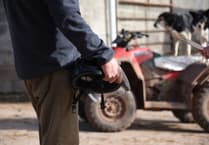Nothing compares to the satisfaction of homegrown harvests – from unbeatable freshness to being cost-effective, growing your own fruits and vegetables is extremely rewarding.
As spring takes hold, April is the perfect time to sow seeds for your kitchen garden or vegetable plot. British Garden Centres takes a look at the vegetables and fruits you can be planting now for some fresh, tasty treats later this year.
Onion sets can be planted mid-April after the last frost, with harvests ready by late summer. Onions need 90–100 days to grow into a good size for your cooking.
Growing onions is straightforward with sets that are readily available in your local garden centre. Plant them in well-drained, fertile soil in a sunny location, spacing them 10–15 cm apart in rows 30 cm apart, ensuring their tips are showing above the soil surface. They are ready to harvest from late July to August when their tops yellow and fall over, then dry them before storage.
Courgettes are among the top choices for April planting. These are best started indoors from seed in early April, using seed tray modules or small pots. Once young seedlings begin to appear, pot on the larger ones into bigger pots and continue to grow them indoors until the frosts have passed.
Then you can plant them outside and space 90cm apart in well-composted soil. Cover the area with a plastic cloche until the seedlings are fully established, especially if still nippy at night. They will be ready to harvest when they reach about 10-12cm in length.
Carrots can be planted directly outdoors in April, as the soil is warming in the spring sunshine. Choose a sunny spot with light, well-drained soil, and prepare it by removing stones and weeds to prevent forked roots. Avoid organic matter in the soil and sow seeds thinly in shallow drills about 1 cm deep, spacing rows 15–30 cm apart.
Make sure you protect seedlings from pests like slugs and carrot fly by using insect-proof mesh or fleece. Successional sowing every few weeks will ensure a steady harvest throughout the season, with early varieties ready in about 10 weeks and main crops maturing in 14–16 weeks.
Squash is another easy crop to grow in your garden or allotment. Sow your seeds 2.5cm deep in compost trays or pots. When the roots become visible through the bottom of your pot, it's time to plant them into larger grow bags or directly into your vegetable patch.
When growing squash outdoors, plant them at least 1.2 meters apart, as the plants trail across the ground and take up a fair bit of space. Mix the soil with organic compost for as squash are heavy feeders, and they will be ready to harvest in autumn.
Beetroot is another excellent choice for April planting and will offer a continuous harvest through to autumn if sown every few weeks. Sow seeds in trays or pots about 1 inch deep in compost. When planting outdoors in late spring, place them 2.5cm deep in rows 20-30cm apart. The beetroot will emerge above the soil, allowing you to pick baby beets or harvest the leaves like spinach. For larger beets, allow about three months of growth from sowing.
Runner beans are easy to grow in gardens or containers. Sow seeds indoors in April or outdoors in May to early June, using multi-purpose compost. After the frost has passed, you can transplant any indoor grown seedlings outside, spacing them 30cm apart in rows 45cm apart. As they grow, you will need to provide support with canes or bamboo tepees. You can harvest the beans when they reach about 20cm long in the summer.
Leek varieties such as Below-Zero’s F1 Hybrid, Blauwgroene Winter Bandits, Musselburgh, Autumn Giant, Pandora, and Lyon can be sown indoors in April. Once germinated, they can be planted outside during the warm spring and summer months and will endure winter conditions, ready for harvest from December to May. Start them in seed trays or pots on a sunny windowsill or greenhouse and plant outdoors when they reach about 20cm tall, using a dibber to create a hole 20cm deep and spacing them 15cm apart.
Peas are the perfect vegetable to start this month. Sow them in a trench 15cm wide and 3-5cm deep, spacing them about 8cm apart in rows, and in well-drained soil. If your peas are tall, you will need stakes for support. Feed them a liquid tomato feed once the pods begin to form and enjoy your fresh harvest in late summer.
Strawberries and raspberries can be planted from early spring indoors. Sow the seeds in moist compost in a seed tray with a lid to seal in moisture and place them somewhere bright and warm, like a greenhouse or windowsill. Once germinated, harden off and plant out once the frosts have passed.
For bare-root plants, ensure they are placed in direct sunlight and planted in well-drained soil for a sweet and tasty crop. Plant the plants 45cm apart with 75cm between each row in sandy, loamy soil that is at least 12 inches deep.
Julian Palphramand, Head of Plants at British Garden Centres, said: “April is the perfect time to sow seeds and plant vegetables, as getting ahead now ensures a bountiful harvest later—focus on cool-season crops like peas and carrots, while preparing for tender varieties indoors. At British Garden Centres, our staff can advise and help you choose the perfect vegetables for your kitchen garden.”




